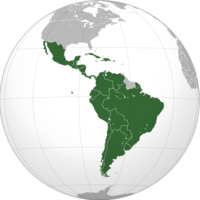Latin America
Latin America, in the broadest sense, is the entire southern portion of the Americas including parts of the Caribbean, Central America and South America. It does not, however, include Suriname, Guyana and French Guiana (an integral part of the French Republic). Latin America has 523 million people, far more than the United States population of about 300 million. It is considered largely Catholic and is Spanish-, French-, and Portuguese-speaking. The region is of crucial political importance to the United States. Former President George W. Bush toured Latin America on a peace mission to try and curb negative influence stemming from Venezuelan dictator Hugo Chavez.[1]
The term "Latin America" (and "Latin American") was invented by the French in the 1860s as part of their goal of controlling Mexico. The term has caught on and usually means the resident of any Spanish-speaking, Portuguese-speaking or French-speaking country south of the U.S.
Though Roman Catholicism is historically dominant in Latin America, evangelical Christianity is rapidly growing, both spiritually and politically.[2] Despite this, the region is relatively unstable, with the largest number of homicides in the world occurring in the region.[3]
References
- ↑ Latin America. George Bush - White House Mar 7, 2007.
- ↑ Puglie, Frederic (February 19, 2018). Evangelicals’ newfound political clout in Latin America unnerves politicians, Catholic Church. The Washington Times. Retrieved February 22, 2018.
- ↑ Suarez Sang, Lucia I. (May 30, 2019). Latin America accounts for one third of world's homicides, life expectancy dropping in some countries: study. Fox News. Retrieved May 30, 2019.
